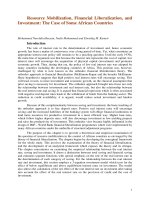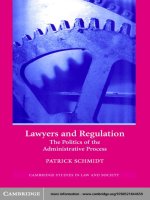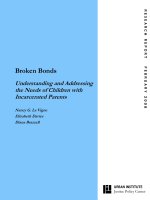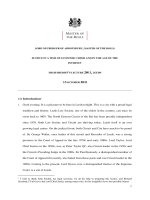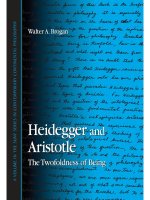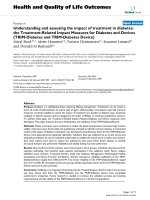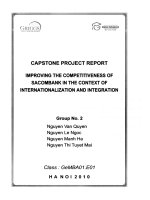Understanding and improving the durability of textiles
Bạn đang xem bản rút gọn của tài liệu. Xem và tải ngay bản đầy đủ của tài liệu tại đây (5.4 MB, 289 trang )
© Woodhead Publishing Limited, 2012
Understanding and improving the durability of textiles
© Woodhead Publishing Limited, 2012
The Textile Institute and Woodhead Publishing
The Textile Institute is a unique organisation in textiles, clothing and footwear.
Incorporated in England by a Royal Charter granted in 1925, the Institute has
individual and corporate members in over 90 countries. The aim of the Institute is
to facilitate learning, recognise achievement, reward excellence and disseminate
information within the global textiles, clothing and footwear industries.
Historically, The Textile Institute has published books of interest to its members
and the textile industry. To maintain this policy, the Institute has entered into
partnership with Woodhead Publishing Limited to ensure that Institute members
and the textile industry continue to have access to high calibre titles on textile
science and technology.
Most Woodhead titles on textiles are now published in collaboration with The
Textile Institute. Through this arrangement, the Institute provides an Editorial
Board which advises Woodhead on appropriate titles for future publication and
suggests possible editors and authors for these books. Each book published under
this arrangement carries the Institute’s logo.
Woodhead books published in collaboration with The Textile Institute are
offered to Textile Institute members at a substantial discount. These books,
together with those published by The Textile Institute that are still in print, are
offered on the Woodhead website at: www.woodheadpublishing.com. Textile
Institute books still in print are also available directly from the Institute’s website
at: www.textileinstitutebooks.com.
A list of Woodhead books on textile science and technology, most of which have
been published in collaboration with The Textile Institute, can be found towards
the end of the contents pages.
© Woodhead Publishing Limited, 2012
Woodhead Publishing Series in Textiles: Number 132
Understanding and
improving the durability
of textiles
Edited by
Patricia A. Annis
Oxford Cambridge Philadelphia New Delhi
© Woodhead Publishing Limited, 2012
Published by Woodhead Publishing Limited in association with The Textile Institute
Woodhead Publishing Limited, 80 High Street, Sawston, Cambridge CB22 3HJ, UK
www.woodheadpublishing.com
www.woodheadpublishingonline.com
Woodhead Publishing, 1518 Walnut Street, Suite 1100, Philadelphia, PA 19102-3406, USA
Woodhead Publishing India Private Limited, G-2, Vardaan House,
7/28 Ansari Road, Daryaganj, New Delhi – 110002, India
www.woodheadpublishingindia.com
First published 2012, Woodhead Publishing Limited
© Woodhead Publishing Limited, 2012. Note: the publisher has made every effort to
ensure that permission for copyright material has been obtained by authors wishing to use
such material. The authors and the publisher will be glad to hear from any copyright
holder it has not been possible to contact.
The authors have asserted their moral rights.
This book contains information obtained from authentic and highly regarded sources.
Reprinted material is quoted with permission, and sources are indicated. Reasonable
efforts have been made to publish reliable data and information, but the authors and the
publisher cannot assume responsibility for the validity of all materials. Neither the
authors nor the publisher, nor anyone else associated with this publication, shall be liable
for any loss, damage or liability directly or indirectly caused or alleged to be caused by
this book.
Neither this book nor any part may be reproduced or transmitted in any form or by
any means, electronic or mechanical, including photocopying, microfilming and record-
ing, or by any information storage or retrieval system, without permission in writing from
Woodhead Publishing Limited.
The consent of Woodhead Publishing Limited does not extend to copying for general
distribution, for promotion, for creating new works, or for resale. Specific permission
must be obtained in writing from Woodhead Publishing Limited for such copying.
Trademark notice: Product or corporate names may be trademarks or registered trade-
marks, and are used only for identification and explanation, without intent to infringe.
British Library Cataloguing in Publication Data
A catalogue record for this book is available from the British Library.
Library of Congress Control Number: 2012942047
ISBN 978-0-85709-087-4 (print)
ISBN 978-0-85709-764-4 (online)
ISSN 2042-0803 Woodhead Publishing Series in Textiles (print)
ISSN 2042-0811 Woodhead Publishing Series in Textiles (online)
The publisher’s policy is to use permanent paper from mills that operate a sustainable
forestry policy, and which has been manufactured from pulp which is processed
using acid-free and elemental chlorine-free practices. Furthermore, the publisher ensures
that the text paper and cover board used have met acceptable environmental accreditation
standards.
Typeset by Ann Buchan (Typesetters), Middlesex, UK
Printed by TJ International Limited, Padstow, Cornwall, UK
v
© Woodhead Publishing Limited, 2012
Contents
Contributor contact details xi
Woodhead Publishing Series in Textiles xiii
Introduction xxi
Part I Aspects of textile durability
1 The influence of fabric construction and fibre
type on textile durability: woven, knitted
and nonwoven fabrics 3
D. PETRULIS, Kaunas University of Technology, Lithuania
1.1 Introduction 3
1.2 Woven, knitted and nonwoven fabric structures 4
1.3 Fibre and yarn properties that affect fabric durability 9
1.4 Durability of woven, knitted and nonwoven fabric structures 14
1.5 Durability of technical textiles: medical and breathable
textiles 22
1.6 Future trends 24
1.7 Sources of further information and advice 26
1.8 Acknowledgement 26
1.9 References 26
2 Strength properties of fabrics: understanding,
testing and enhancing fabric strength 31
J. N. CHAKRABORTY, National Institute of Technology, India
2.1 Introduction 31
2.2 Principles of fabric strength and its influence on durability 34
2.3 Methods for testing fabric strength 40
vi Contents
© Woodhead Publishing Limited, 2012
2.4 Factors affecting fabric strength 45
2.5 Approaches to enhance fabric strength 50
2.6 Examples of durable textiles 53
2.7 Future trends 55
2.8 Sources of further information and advice 56
2.9 References 56
3 Dimensional stability of fabrics: resistance to
shrinkage and other dimensional changes 59
S. F. NG,C.L.HUI and C. IP, The Hong Kong Polytechnic
University, China
3.1 Introduction 59
3.2 Types of shrinkage 60
3.3 Treatments to maximise dimensional stability in fabrics 62
3.4 Case study: minimising shrinkage in knitted fabrics 65
3.5 Future trends 68
3.6 References 68
4 Durable press treatments to improve the durability
and wrinkle resistance of cotton and other fabrics 70
W. XU and X. WANG, Wuhan Textile University, China
4.1 Introduction 70
4.2 Development of durable press reagents 72
4.3 Properties affected by durable press treatments and other
methods to improve durability 75
4.4 Recent developments and future trends 78
4.5 References 79
5 Colour fastness 82
J. VALLDEPERAS-MORELL and F. CARRILLO-NAVARRETE, Universitat
Politècnica de Catalunya, Spain
5.1 Introduction 82
5.2 Principles of colour fastness 83
5.3 Colour fastness and dye–fibre system mechanism 87
5.4 Testing colour fastness 91
5.5 Applications and examples of colour fastness tests 95
5.6 Future trends 100
5.7 Sources of further information and advice 101
5.8 References 102
Contents vii
© Woodhead Publishing Limited, 2012
6 Effects of light exposure on textile durability 104
V. R UBEZIENE, S. VARNAITE, J. BALTUSNIKAITE and I. PADLECKIENE,
SRI Center for Physical Sciences and Technology Textile Institute,
Lithuania
6.1 Introduction 104
6.2 The influence of sunlight on natural fibres 105
6.3 The influence of sunlight on synthetic and high
performance textiles 108
6.4 The process of photochemical destruction of textile
materials 112
6.5 Assessing the durability of textiles to light exposure 115
6.6 Methods for improving the durability of textiles
exposed to light 117
6.7 Future trends 121
6.8 References 121
7 Testing textile durability 126
M. BIDE, University of Rhode Island, USA
7.1 Introduction 126
7.2 Durability in textiles 127
7.3 Textile test methods 128
7.4 Testing strength and abrasion resistance 133
7.5 Testing for color loss in use 135
7.6 Testing the effects of laundering on fabric properties 137
7.7 Conclusions 141
7.8 References 141
Part II Durability of particular types of textiles
8 Durable antimicrobial textiles: types, finishes
and applications 145
V. P. D HENDE, I. R. HARDIN and J. LOCKLIN, University of Georgia,
USA
8.1 Introduction 145
8.2 Microbial degradation of natural fibers 146
8.3 Microbial degradation of synthetic fibers 149
8.4 Antimicrobial treatments for textiles 151
viii Contents
© Woodhead Publishing Limited, 2012
8.5 Applications of antimicrobial finishes: the example of
medical textiles 164
8.6 Future trends and conclusions 164
8.7 Sources of further information and advice 165
8.8 References 165
9 Durability of protective clothing 174
A. SHAW, University of Maryland Eastern Shore, USA
9.1 Introduction 174
9.2 Testing the durability of protective clothing 176
9.3 Other factors that can affect the durability of protective
clothing 179
9.4 Future trends and conclusions 181
9.5 References 182
10 Durability of historic textiles 184
P. G ARSIDE, British Library, UK
10.1 Introduction 184
10.2 Main durability issues that affect historic textiles 185
10.3 Durability of different fibres and fabrics 188
10.4 Physical context, environment and storage conditions 192
10.5 Conservation of historic textiles 194
10.6 Case studies of historic textiles 195
10.7 Conclusion 200
10.8 References 201
11 Silk durability and degradation 205
N. LUXFORD, University College London, UK
11.1 Introduction 205
11.2 Key issues for silk durability 206
11.3 Deterioration of silk 210
11.4 Methods to improve the durability of silk 214
11.5 The impact of treatments to improve the durability of silk 219
11.6 Future trends 223
11.7 Sources of further information and advice 224
11.8 References 225
Contents ix
© Woodhead Publishing Limited, 2012
12 Durable geotextiles 233
H Y. JEON, Inha University, Republic of Korea
12.1 Introduction 233
12.2 Durability of nonwoven geotextiles in chemical
and waste leachate solutions 234
12.3 Protection performance of nonwoven geotextiles in waste
landfill 240
12.4 Weatherability of woven geotextiles for soft ground
improvement 249
12.5 Durability of nonwoven geotextiles in simulated
seawater solution 255
12.6 Conclusions 260
12.7 References 260
Index 263
xi
© Woodhead Publishing Limited, 2012
Contributor contact details
(* = main contact)
Editor
Patricia A. Annis
Associate Professor
College of Family and Consumer
Sciences
The University of Georgia
309 Dawson Hall
305 Sanford Drive
Athens, GA 30602
USA
Email:
Chapter 1
Prof. Donatas Petrulis
Department of Textile Technology
Kaunas University of Technology
Studentu 56
LT-51424 Kaunas
Lithuania
Email:
Chapter 2
Prof. J. N. Chakraborty
Department of Textile Technology
National Institute of Technology
Po. REC
Jalandhar 144011
India
Email: ;
Chapter 3
Prof. Sau-fun Ng*, Prof. C. L. Hui and
C. Ip
Institute of Textiles and Clothing
The Hong Kong Polytechnic University
Hung Hom, Kowloon
Hong Kong
Email:
Chapter 4
Prof. Weilin Xu* and A. Prof. Xin
Wang
School of Textile Science and
Engineering
Wuhan Textile University
Wuhan 430200
China
Email: ;
Chapter 5
Prof. José Valldeperas-Morell* and
Prof. Fernando Carrillo-Navarrete
INTEXTER
Universitat Politècnica de Catalunya
Colom 15
Terrassa 08222
Spain
Email: ;
xii Contributor contact details
© Woodhead Publishing Limited, 2012
Chapter 6
Dr Vitalija Rubeziene*, Dr Sandra
Varnaite, Dr Julija Baltusnikaite and
Dr Ingrida Padleckiene
SRI Center for Physical Sciences and
Technology Textile Institute
Demokratø g. 53
LT-48485, Kaunas
Lithuania
Email: *;
;
;
Chapter 7
Martin Bide
Department of Textiles, Fashion Mer-
chandising and Design
University of Rhode Island
55 Lower College Rd
Kingston
RI 02881
USA
Email:
Chapter 8
V. P. Dhende, Ian R. Hardin* and
J. Locklin
Department of Textiles, Merchandis-
ing & Interiors
University of Georgia
Athens
GA 30602
USA
Email:
Chapter 9
Anugrah Shaw
Richard Henson Center, Room 2113
University of Maryland Eastern Shore
Princess Anne
MD 21853
USA
Email:
Chapter 10
Paul Garside
British Library
96 Euston Road
London NW1 2DB
UK
Email:
Chapter 11
Dr Naomi Luxford
Post-doctoral Research Fellow
Centre for Sustainable Heritage
Bartlett School of Graduate Studies
University College London
Central House
14 Upper Woburn Place
London WC1H 0NN
UK
Email:
Chapter 12
Prof. H Y. Jeon
Division of Nano-systems Engineering
Inha University
253 Yonghyun-dong, Nam-gu
Incheon, 402-751
Republic of Korea
Email:
xiii
© Woodhead Publishing Limited, 2012
Woodhead Publishing Series in Textiles
1 Watson’s textile design and colour Seventh edition
Edited by Z. Grosicki
2 Watson’s advanced textile design
Edited by Z. Grosicki
3 Weaving Second edition
P. R. Lord and M. H. Mohamed
4 Handbook of textile fibres Volume 1: Natural fibres
J. Gordon Cook
5 Handbook of textile fibres Volume 2: Man-made fibres
J. Gordon Cook
6 Recycling textile and plastic waste
Edited by A. R. Horrocks
7 New fibers Second edition
T. Hongu and G. O. Phillips
8 Atlas of fibre fracture and damage to textiles Second edition
J. W. S. Hearle, B. Lomas and W. D. Cooke
9 Ecotextile ’98
Edited by A. R. Horrocks
10 Physical testing of textiles
B. P. Saville
11 Geometric symmetry in patterns and tilings
C. E. Horne
12 Handbook of technical textiles
Edited by A. R. Horrocks and S. C. Anand
13 Textiles in automotive engineering
W. Fung and J. M. Hardcastle
14 Handbook of textile design
J. Wilson
15 High-performance fibres
Edited by J. W. S. Hearle
xiv Woodhead Publishing Series in Textiles
© Woodhead Publishing Limited, 2012
16 Knitting technology Third edition
D. J. Spencer
17 Medical textiles
Edited by S. C. Anand
18 Regenerated cellulose fibres
Edited by C. Woodings
19 Silk, mohair, cashmere and other luxury fibres
Edited by R. R. Franck
20 Smart fibres, fabrics and clothing
Edited by X. M. Tao
21 Yarn texturing technology
J. W. S. Hearle, L. Hollick and D. K. Wilson
22 Encyclopedia of textile finishing
H-K. Rouette
23 Coated and laminated textiles
W. Fung
24 Fancy yarns
R. H. Gong and R. M. Wright
25 Wool: Science and technology
Edited by W. S. Simpson and G. Crawshaw
26 Dictionary of textile finishing
H-K. Rouette
27 Environmental impact of textiles
K. Slater
28 Handbook of yarn production
P. R. Lord
29 Textile processing with enzymes
Edited by A. Cavaco-Paulo and G. Gübitz
30 The China and Hong Kong denim industry
Y. Li, L. Yao and K. W. Yeung
31 The World Trade Organization and international denim trading
Y. Li, Y. Shen, L. Yao and E. Newton
32 Chemical finishing of textiles
W. D. Schindler and P. J. Hauser
33 Clothing appearance and fit
J. Fan, W. Yu and L. Hunter
34 Handbook of fibre rope technology
H. A. McKenna, J. W. S. Hearle and N. O’Hear
35 Structure and mechanics of woven fabrics
J. Hu
36 Synthetic fibres: nylon, polyester, acrylic, polyolefin
Edited by J. E. McIntyre
Woodhead Publishing Series in Textiles xv
© Woodhead Publishing Limited, 2012
37 Woollen and worsted woven fabric design
E. G. Gilligan
38 Analytical electrochemistry in textiles
P. Westbroek, G. Priniotakis and P. Kiekens
39 Bast and other plant fibres
R. R. Franck
40 Chemical testing of textiles
Edited by Q. Fan
41 Design and manufacture of textile composites
Edited by A. C. Long
42 Effect of mechanical and physical properties on fabric hand
Edited by H. M. Behery
43 New millennium fibers
T. Hongu, M. Takigami and G. O. Phillips
44 Textiles for protection
Edited by R. A. Scott
45 Textiles in sport
Edited by R. Shishoo
46 Wearable electronics and photonics
Edited by X. M. Tao
47 Biodegradable and sustainable fibres
Edited by R. S. Blackburn
48 Medical textiles and biomaterials for healthcare
Edited by S. C. Anand, M. Miraftab, S. Rajendran and J. F. Kennedy
49 Total colour management in textiles
Edited by J. Xin
50 Recycling in textiles
Edited by Y. Wang
51 Clothing biosensory engineering
Y. Li and A. S. W. Wong
52 Biomechanical engineering of textiles and clothing
Edited by Y. Li and D. X-Q. Dai
53 Digital printing of textiles
Edited by H. Ujiie
54 Intelligent textiles and clothing
Edited by H. R. Mattila
55 Innovation and technology of women’s intimate apparel
W. Yu, J. Fan, S. C. Harlock and S. P. Ng
56 Thermal and moisture transport in fibrous materials
Edited by N. Pan and P. Gibson
57 Geosynthetics in civil engineering
Edited by R. W. Sarsby
xvi Woodhead Publishing Series in Textiles
© Woodhead Publishing Limited, 2012
58 Handbook of nonwovens
Edited by S. Russell
59 Cotton: Science and technology
Edited by S. Gordon and Y-L. Hsieh
60 Ecotextiles
Edited by M. Miraftab and A. R. Horrocks
61 Composite forming technologies
Edited by A. C. Long
62 Plasma technology for textiles
Edited by R. Shishoo
63 Smart textiles for medicine and healthcare
Edited by L. Van Langenhove
64 Sizing in clothing
Edited by S. Ashdown
65 Shape memory polymers and textiles
J. Hu
66 Environmental aspects of textile dyeing
Edited by R. Christie
67 Nanofibers and nanotechnology in textiles
Edited by P. Brown and K. Stevens
68 Physical properties of textile fibres Fourth edition
W. E. Morton and J. W. S. Hearle
69 Advances in apparel production
Edited by C. Fairhurst
70 Advances in fire retardant materials
Edited by A. R. Horrocks and D. Price
71 Polyesters and polyamides
Edited by B. L. Deopura, R. Alagirusamy, M. Joshi and B. S. Gupta
72 Advances in wool technology
Edited by N. A. G. Johnson and I. Russell
73 Military textiles
Edited by E. Wilusz
74 3D fibrous assemblies: Properties, applications and modelling of three-
dimensional textile structures
J. Hu
75 Medical and healthcare textiles
Edited by S. C. Anand, J. F. Kennedy, M. Miraftab and S. Rajendran
76 Fabric testing
Edited by J. Hu
77 Biologically inspired textiles
Edited by A. Abbott and M. Ellison
78 Friction in textile materials
Edited by B. S. Gupta
Woodhead Publishing Series in Textiles xvii
© Woodhead Publishing Limited, 2012
79 Textile advances in the automotive industry
Edited by R. Shishoo
80 Structure and mechanics of textile fibre assemblies
Edited by P. Schwartz
81 Engineering textiles: Integrating the design and manufacture of textile
products
Edited by Y. E. El-Mogahzy
82 Polyolefin fibres: Industrial and medical applications
Edited by S. C. O. Ugbolue
83 Smart clothes and wearable technology
Edited by J. McCann and D. Bryson
84 Identification of textile fibres
Edited by M. Houck
85 Advanced textiles for wound care
Edited by S. Rajendran
86 Fatigue failure of textile fibres
Edited by M. Miraftab
87 Advances in carpet technology
Edited by K. Goswami
88 Handbook of textile fibre structure Volume 1 and Volume 2
Edited by S. J. Eichhorn, J. W. S. Hearle, M. Jaffe and T. Kikutani
89 Advances in knitting technology
Edited by K-F. Au
90 Smart textile coatings and laminates
Edited by W. C. Smith
91 Handbook of tensile properties of textile and technical fibres
Edited by A. R. Bunsell
92 Interior textiles: Design and developments
Edited by T. Rowe
93 Textiles for cold weather apparel
Edited by J. T. Williams
94 Modelling and predicting textile behaviour
Edited by X. Chen
95 Textiles, polymers and composites for buildings
Edited by G. Pohl
96 Engineering apparel fabrics and garments
J. Fan and L. Hunter
97 Surface modification of textiles
Edited by Q. Wei
98 Sustainable textiles
Edited by R. S. Blackburn
99 Advances in yarn spinning technology
Edited by C. A. Lawrence
xviii Woodhead Publishing Series in Textiles
© Woodhead Publishing Limited, 2012
100 Handbook of medical textiles
Edited by V. T. Bartels
101 Technical textile yarns
Edited by R. Alagirusamy and A. Das
102 Applications of nonwovens in technical textiles
Edited by R. A. Chapman
103 Colour measurement: Principles, advances and industrial
applications
Edited by M. L. Gulrajani
104 Fibrous and composite materials for civil engineering applications
Edited by R. Fangueiro
105 New product development in textiles: Innovation and production
Edited by L.Horne
106 Improving comfort in clothing
Edited by G. Song
107 Advances in textile biotechnology
Edited by V. A. Nierstrasz and A. Cavaco-Paulo
108 Textiles for hygiene and infection control
Edited by B. McCarthy
109 Nanofunctional textiles
Edited by Y. Li
110 Joining textiles: Principles and applications
Edited by I. Jones and G. Stylios
111 Soft computing in textile engineering
Edited by A. Majumdar
112 Textile design
Edited by A. Briggs-Goode and K. Townsend
113 Biotextiles as medical implants
Edited by M. King and B. Gupta
114 Textile thermal bioengineering
Edited by Y. Li
115 Woven textile structure
B. K. Behera and P. K. Hari
116 Handbook of textile and industrial dyeing. Volume 1: Principles,
processes and types of dyes
Edited by M. Clark
117 Handbook of textile and industrial dyeing. Volume 2: Applications of
dyes
Edited by M. Clark
118 Handbook of natural fibres. Volume 1: Types, properties and factors
affecting breeding and cultivation
Edited by R. Kozlowski
Woodhead Publishing Series in Textiles xix
© Woodhead Publishing Limited, 2012
119 Handbook of natural fibres. Volume 2: Processing and applications
Edited by R. Kozlowski
120 Functional textiles for improved performance, protection and health
Edited by N. Pan and G. Sun
121 Computer technology for textiles and apparel
Edited by J. Hu
122 Advances in military textiles and personal equipment
Edited by E. Sparks
123 Specialist yarn and fabric structures
Edited by R. H. Gong
124 Handbook of sustainable textile production
M. I. Tobler-Rohr
125 Woven textiles: Principles, developments and applications
Edited by K. Gandhi
126 Textiles and fashion: Materials design and technology
Edited by R. Sinclair
127 Industrial cutting of textile materials
I. Viïumsone-Nemes
128 Colour design: Theories and applications
Edited by J. Best
129 False twist textured yarns
C. Atkinson
130 Modelling, simulation and control of the dyeing process
R. Shamey and X. Zhao
131 Process control in textile manufacturing
Edited by A. Majumdar, A. Das, R. Alagirusamy and V. K. Kothari
132 Understanding and improving the durability of textiles
Edited by P. A. Annis
133 Smart textiles for protection
Edited by R. Chapman
134 Functional nanofibers and applications
Edited by Q. Wei
135 The global textile and clothing industry: Technological advances and
future challenges
Edited by R. Shishoo
136 Simulation in textile technology: Theory and applications
Edited by D. Veit
137 Pattern cutting for clothing using CAD: How to use Lectra Modaris
pattern cutting software
M. Stott
138 Advances in the dyeing and finishing of technical textiles
M. L. Gulrajani
xx Woodhead Publishing Series in Textiles
© Woodhead Publishing Limited, 2012
139 Multidisciplinary know-how for smart textile development
T. Kirstein
140 Handbook of fire resistant textiles
F S. Kilinc-Balci
141 Handbook of footwear design and manufacture
A. Luximon
142 Textile-led design for the active ageing population
J. McCann and D. Bryson
143 Optimizing decision making in clothing management using artificial
intelligence (AI): From production to fashion retail
W. K. Wong, Z. X. Guo and S. Y. S. Leung
144 Mechanisms of flat weaving technology
V. Choogin, P. Bandara and E. Chepelyuk
145 Innovative jacquard textile design using digital technologies
F. Ng and J. Zhou
146 Advances in shape memory polymers
J. Hu
147 Clothing manufacture management: A systematic approach to
planning, scheduling and control
J. Gersak
148 Anthropometry, apparel sizing and design
D. Gupta and N. Zakaria
xxi
© Woodhead Publishing Limited, 2012
Introduction
P. A. ANNIS, University of Georgia, USA
Textile durability is the measure of the ability of a textile to endure and to maintain
its essential and distinctive characteristics of strength, dimension, and appearance.
Durability is determined by the length of time that a textile can maintain its innate
characteristics in use. This time will vary depending on characteristics of the
textile in question, the amount and degree of use, and the environment.
1
The characteristics and performance of a textile are determined by its basic
structural components, i.e. fiber, yarn, fabric structure, finishing treatments, and
the interaction of these components with each other. Failure of one or more of
these components will adversely affect the durability of a textile material. The
amount and degree of use are determined by the type of textile in question and vary
widely depending upon the individual user and application of the textile material.
Exposure to the environment can be as simple as use in the indoor environment
accompanied by refurbishing and care to as complex as burial in the ground. A
user’s expectations for serviceability also influence judgment about the durability
of a textile. Finally, the scope of durability of textile materials should not be limited
to physical integrity but also should encompasses a textile’s resistance to changes
in dimension, appearance and color.
Thus, understanding and improving textile durability is a complex endeavor.
The approach taken in this book is to discuss the durability of textile materials in
two parts. In Part I, the many aspects of textile science that contribute to textile
durability are discussed. Part II is devoted to case studies of the durability of
particular types of textiles. Test methods used to evaluate specific aspects of
textile durability and recent developments and future trends are part of each
chapter in both sections of the book.
The effects of the interaction of fabric construction, yarn structure, and fiber
characteristics on textile durability are addressed in detail in Chapter 1. This
discussion includes woven, knit, and nonwoven fabrics, as well as advanced
constructions and textile composites. Strength and abrasion resistance are often
considered to be synonymous with textile durability. Thus, enhancing the strength
properties of a textile by judicious selection and manipulation of its structural
components are the focus of Chapter 2. Chapter 3 addresses durability in terms of
dimensional stability. Understanding how the components of a textile interact to
influence its dimensional stability, as well as approaches to maintaining the
dimensions of fabrics during processing, use, and care are the focus of Chapter 3.
xxii Introduction
© Woodhead Publishing Limited, 2012
Improving appearance retention through durable press treatments is the topic of
Chapter 4. Although improvement of smoothness is a desirable attribute, durable
press treatments may adversely affect the physical durability of fabrics. Thus, the
mechanisms and technology of durable press finishing are described in the context
of maintaining the physical integrity of treated fabrics. The many and varied
aspects of the colorfastness of textiles are described in Chapter 5. Color instability
has implications for the discussion of textile durability. Poor durability of color
characteristics may result in a textile being discarded long before it is physically
‘worn out’. Resistance to degradation by ultraviolet (UV) radiation is an important
characteristic of many types of outdoor textiles and is a critical requirement for
some protective fabrics. Chapter 6 discusses the detrimental effects of light on
textiles and how resistance to photo degradation can be improved. Chapter 7
concludes Part I of the book with an overview of the many types of test methods
used to measure and predict the durability of textile materials.
The durability of particular types of textiles is given extensive treatment in Part
II of this book. Chapter 8 discusses how the durability of textiles can be improved
using antimicrobial agents. Durable antimicrobial agents are used to protect the
user of a textile or the textile itself from biodegradation by microorganisms.
Chapter 9 draws attention to changes in durability of textiles during use and care
that may affect the performance of clothing with a variety of protective functions.
Performance assessments based on laboratory tests of preconditioned new gar-
ments may not be comparable to the wear and tear that garments undergo during
actual use. Factors that influence the durability of historic textiles are discussed in
Chapter 10. Not unlike contemporary textiles, interaction of the textile structural
characteristics – i.e. fiber, yarn, and fabric – influence durability as well as other
considerations specific to historic textiles such as physical context, environmental
factors, storage conditions, and conservation practices. Chapter 11 outlines the
deterioration processes that limit the durability of historic silk and current treat-
ments used to improve the durability of modern silk. The long-term effects of
preventive conservation on the durability of silk also are discussed using a historic
house case study. Geotextiles (textiles used on or in the ground) have a wide
variety of functional applications; Chapter 12 describes assessment of the physical
and chemical properties that influence the durability of woven and nonwoven
geotextiles used in landfill and ground stabilization applications.
As editor of this book, I would like to thank the various individual chapter
contributors and the staff of Woodhead Publishing Limited for making this book
possible. The information presented should contribute significantly to the litera-
ture on understanding and improving the durability of textile materials.
Reference
1. ASTM International Online Dictionary of Engineering Science and Technology (2012)
/>3
© Woodhead Publishing Limited, 2012
1
The influence of fabric construction and fibre
type on textile durability: woven, knitted
and nonwoven fabrics
D. PETRULIS, Kaunas University of Technology, Lithuania
Abstract: This chapter discusses fabric construction and its effect on fabric
durability. The chapter first reviews the importance of understanding fabric
construction. It then describes types of textile structures and construction
indices. The properties of fibres and yarns and fabric construction indices that
affect fabric durability are given. Basic data and the most recent information
on the durability of woven fabrics, knitted fabrics and nonwovens are
provided. At the end of this chapter, the durability of advanced examples of
textile structures and the future trends of durable textile structures are
discussed.
Key words: fabric construction, fabric durability, knitted fabrics,
nonwovens, woven fabrics.
1.1 Introduction
The construction of materials is a significant factor in their initial properties which
influences the functionality of materials during their use. ‘Construction’ is a
general term used in textiles that refers to fibre, yarn and fabric dimensions, and
also to the manner in which the elements of the textile material are arranged in its
structure.
Constructions of textile materials are seldom designed to withstand a single
stress application of high magnitude. Fabrics are subjected to long usage and,
during their lifetime, will experience a series of repeated stress applications and
removals. Tensioning, buckling, flexing, and abrasion are examples of such
repeated stress applications. Unidirectional, bidirectional or multi-directional
influences will occur during wear. It is therefore essential that the design of textile
structures takes into account the nature of the damage and construction changes to
which the materials will be subjected in actual use.
Engineered fabric manufacturing requires a thorough understanding of durabil-
ity properties and their key control construction parameters. The wear life of
fabrics is complex, not only because of the many different factors of fabric
construction over a variety of structural levels, but also because the relative
importance of each will differ greatly according to the conditions of wear.
4 Understanding and improving the durability of textiles
© Woodhead Publishing Limited, 2012
As far as is known, the first significant studies in this field (Hamburger, 1945;
Morton, 1948; Backer, 1951; and others) were made in the middle of the 20th
century. For instance, in 1945 Hamburger studied the mechanics of abrasion in
textile materials. In this study, two essentially different classes of factors govern-
ing abrasion resistance in textile structures were noted: the inherent abrasion
resistance of the material and the geometry of the composite structure. The latter
may be characterised as the ‘form factor’. The effect of the geometric form factor
is more pronounced in structures such as woven, knitted and other fabrics made
from yarns than it is in sheets, films and extruded items. It should be noted that the
face and the back of certain woven fabrics resist abrasion quite differently because
of the geometric form factors.
Through the use of various combinations of diameter, spacing and the manner
in which yarns are interlaced, numerous factors may be introduced to ensure that
the fabric does not behave in the same manner as the homogeneous material of
which it is chemically constituted. The literature shows that fabric durability is
recognised as a complex phenomenon involving many factors, including the type
of fibre, the yarn geometry and the fabric parameters.
In this chapter, the role of fabric construction in durability is discussed. Various
types of fabric constructions are studied and their different geometric parameters
submitted for consideration. Fabric durability is so complex a mechanism that the
effect of one factor is often masked by interactions with others. This chapter
discusses the geometric aspects of textile materials and their influence on durabil-
ity, and points out problems that require further investigation.
1.2 Woven, knitted and nonwoven fabric structures
Different levels of textile materials structure, i.e. fibre level, yarn level, and fabric
construction level, can be applied to fabrics that are not homogeneous isotropic
materials. Figure 1.1 shows that there are three main types of fabrics: woven,
knitted and nonwovens. As indicated in Fig. 1.1, these may be further subdivided
into several classes. Fabrics represent a two-phase system of air and fibre. Fibres
and/or yarns, and sometimes other materials, are components of a fabric construc-
tion. In a typical yarn, each fibre is helically twisted, or compacted by other means,
into a cylinder of varying hardness with other rod-like fibres that differ somewhat
in diameter, length, cross-section and morphology. Conventional woven fabrics of
two-dimensional (2D) structure are made by interlacing two sets of yarns at right
angles to each other. The yarns running along the cloth length are called the warp;
the yarns in the perpendicular direction, the weft. The weave, together with yarn
linear density and thread spacing, determines the construction of woven fabric.
There is a very large variety of weaves in woven fabrics, but plain, twill and satin
weaves are the basic (elementary) weaves that are widely applied in a great number
of single woven fabrics. In the plain weave structure, as shown in Fig. 1.2(a), each
warp yarn interlaces with each weft yarn alternately, on the one-up/one-down
Influence of fabric construction and fibre type on textile durability 5
© Woodhead Publishing Limited, 2012
1.1 Main types of fabric construction.
principle. Thus the plain weave represents the closest possible interlacing of warp
and weft. In twill weaves, the warp or weft floats on the surface of the fabric
producing a diagonal pattern (Z or S twill lines). Figure 1.2(b) shows a 1/3 twill
weave with a Z twill line. The twill lines are produced by allowing all the warp ends
to interlace in the same way, but displacing the interlacing points of each end by
one pick relative to that of the previous end. Satin weaves have long yarn floats
(over four yarns minimum), with a progression of interlacing by a defined number
(over two yarns minimum). If the warp covers the surface, as shown in Fig. 1.2(c),
the fabric is called warp satin cloth. When weft yarns predominate on the face of
the fabric (see Fig. 1.2(d)), sateen is produced, a weft-faced fabric. Other classes
of weaves are derivative, combined and complex weaves. Besides the above-
mentioned single fabrics, there are compound woven fabrics, e.g. double, treble
cloths, tubular fabrics, pile fabrics, three-dimensional (3D) fabrics and tri-axial
fabrics.
Knitted fabric can be made by inter-looping from a single yarn or an assembly
of yarns. In a knitted structure, the basic element is a needle loop. The knitted stitch
is the basic unit of inter-meshing and there will usually be three or more intermeshed
needle loops in a knitted stitch. Knitted structures may be composed of stitches
containing both open and closed loops.
Woven fabrics
Single woven fabrics
Compound woven fabrics
Fabrics
Knitted fabrics
Weft knitted fabrics
Warp knitted fabrics
Stitchbonded fabrics
Adhesive-bonded fabrics
Spunbonded fabrics
Spunlaced fabrics
Needlebonded fabrics
Nonwovens

